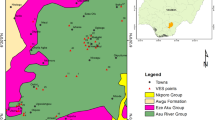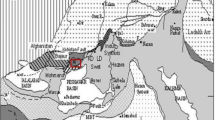Abstract
For the delineation of water-bearing fractures in hard rock areas, a new hydro-chemical technique has been developed which is based on electrical conductivity (EC) logs. The EC logs were carried out in experimental shallow bore wells (≈50 m) in three different parts of India. A sharp variation in EC was observed near water-bearing fractures in hard rock areas. To access applications of this technique, different locations in India were selected and experimental bore wells (≈50 m) were drilled. These were:
-
(1)
Maheswaram (30 km South of Hyderabad): nine shallow bore wells in a watershed of 60 km2 in granitic aquifers,
-
(2)
Wailpally (60 km East of Hyderabad): four shallow bore wells in a watershed of 50 km2 in granitic terrain.
-
(3)
Sadras (60 km SSW of Chennai): four shallow bore wells in a watershed 12 km2 in a charnokite aquifers.
Observations on EC logs were made at short intervals of 1.0 m from the water table (narrow spacing wherever required) until reaching the bottom of the wells. EC showed remarkable changes in value, which was attributed to the presence of water-bearing fractures in the hard rock areas. The results of this study are in good agreement with geophysical and geological findings. In addition to identifying the water-bearing fractures, the EC logs also provide various other hydrological and hydrochemical information, i.e., water table, total depth of the bore well, total dissolved solids (TDS), behavior of water–rock interaction, water quality, information about the chemistry of aquifers, etc.






Similar content being viewed by others
References
Acworth RI (1987) The development of crystalline basement aquifers in a tropical environment. Q J Eng Geol 20:265–272
Ballukraya PN, Sakthivadivel R, Barathan R (1983) Breaks in resistivity sounding curves as indicators of hard rock aquifers. Nordic Hydrol 14:33–40
Charlier JB (2002) Contribution to hydrology in monsoon area study cases in Andhra Pradesh, India. NGRI tech report no. NGRI-September-2002, p 54
Harvey FE, Lee DR, Rudolph DL, Frape SK (1997) Locating groundwater discharge in large lakes using bottom sediment electrical conductivity mapping. Water Resour Res 33(11):2609–2615
Krishnamurthy NS, Syama Prasad B, Zamam G, Anjamneyulu GR, Jain SC (2001) Well logging for identifying fractures zones in boreholes in Maheshwaram watershed, Andhra Pradesh, India. NGRI tech. report no NGRI-2001-GW-322, pp 1–40
Lee DR (1985) Method for locating sediment anomalies in lakebeds that can be caused by groundwater flow. J Hydrol 79:187–193
Lee DR, Milton GM, Cornett RJ, Welch SJ (1991) Location and assessment of groundwater discharge. In: Proceedings of the 2nd annual international conference on high level radioactive waste management, vol 2. American Nuclear Society, LaGrange Park, I11, 1276–1283
Muralidharan D (1996) A semi-quantitative approach to detect aquifers in hard rocks from apparent resistivity data. J Geol Soc India 47:237–242
Revil A, Leroy P (2001) Hydroelectric coupling in a clayey material. Geophys Res Lett 28(8):1643–1646
Sarma JVV, Prasad NVBSS, Rajendra PP (1979) The effect of hydrogeology on variation in the electrical conductivity of groundwater fluctuations. J Hydrol 44(1–2):81–87
Sasidhar P (1993) Safety assessment of low level radioactive waste disposal facility at Kalpakkam. PhD Thesis, Anna University
Satpathy CC, Mathur PK, Nair KVK (1987) Contribution of Edayur-Sadras estuarine system to the hydrographic characteristics of Kalpakkam coastal waters. J Mar Biol Assoc 29(1–2):344–350
Saxena VK, Ahmed S (2001) Dissolution of fluoride in groundwater: a water-rock interaction study. Environ Geol 40:1084–1087
Saxena VK, Singh VS, Mondal NC, Jain SC (2003) Use of hydrochemical parameters for the identification of fresh groundwater resources, Potharlanka Island, India. Environ Geol 44(5):516–521
Saxena VK, Mondal NC, Singh VS (2004) Identification of seawater ingress using Strontium and Boron in Krishna delta, India. Curr Sci 86(4):586–590
Subrahmanyam K, Ahmed S, Dhar RL (2000) Geological and hydrogeological investigations in the Maheshwaram watershed, Ranga Reddy District, Andhra Pradeh, India. Tech report no. NGRI-2000-GW-292
Tsang CF, Hufschmied P, Hale FV (1990) Determination of fracture inflow parameter with a borehole fluid conductivity logging method. Water Resour Res 26(4):561–578
World Health Organization (WHO) (1984) Guideline of drinking quality. World Health Organization, Washington, pp 333–335
Acknowledgements
The authors are grateful to Dr. V.P. Dimri, Director, NGRI, Hydreabad for his encouragement to carry out this work and kind permission to publish this paper. Second author (N.C. Mondal) is also thankful to the Council of Scientific & Industrial Research (CSIR), New Delhi for their partial financial support. We are thankful to our anonymous reviewer for his valuable suggestions.
Author information
Authors and Affiliations
Corresponding author
Rights and permissions
About this article
Cite this article
Saxena, V.K., Mondal, N.C., Singh, V.S. et al. Identification of water-bearing fractures in hard rock terrain by electrical conductivity logs, India. Environ Geol 48, 1084–1095 (2005). https://doi.org/10.1007/s00254-005-0047-6
Received:
Accepted:
Published:
Issue Date:
DOI: https://doi.org/10.1007/s00254-005-0047-6




